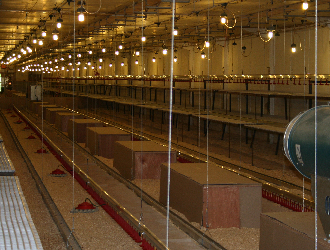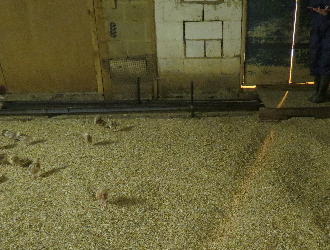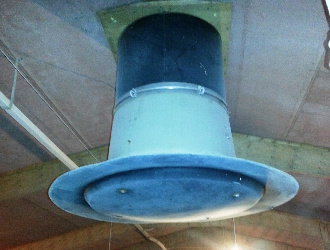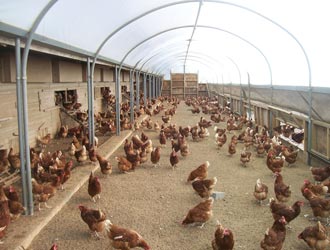The house environment
The environment and climate in the house can be a risk factor for injurious pecking developing. Environmental conditions such as lighting, temperature and ammonia need to be carefully controlled and monitored.
Lighting
Avoid sudden changes in light levels. Light levels at rear shouldn’t be too low as the birds are likely to experience bright conditions in the laying shed. The lighting system should include a means to dim the light levels, to facilitate a gradual change in light intensity if a change is necessary. Dimming the lights should not be the first method used to control injurious feather pecking but a last resort or emergency measure.

|
|
 |
| Lighting should be installed to give an even distribution of light throughout the house. Variations in the intensity of light can be a significant trigger for injurious pecking. |
Bright spots or shafts of light can also trigger injurious pecking. |
Climate
Try to avoid large changes in temperature, humidity and air quality within the house. This can be difficult to achieve in the laying house, but is more feasible in the rearing house. Sudden or extreme variations in house climate can be a source of stress to the birds. Discussions with industry experts point towards climate having a significant effect on the evenness of the flock at rear.
Ammonia depresses feed intake, can inflame the trachea and makes birds more susceptible to diseases such as infectious bronchitis. The hens should not be subjected to concentrations of atmospheric ammonia that are higher than 25 ppm. In practice aim for a maximum of 15 ppm. This should be a good balance between retaining environmental temperature and ammonia levels the pullet can live with.
 |
|
 |
| Ensure the fans are working effectively and vary them according to external temperatures. Minimum ventilation to remove stale gases and moisture should be maintained even in cold weather. |
Verandas will help to reduce the contrast of any extremes in light and temperature between the range and the house. |